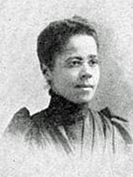Ella D. Barrier
Ella D. Barrier | |
|---|---|
 | |
| Born | 1852 Brockport, New York |
| Died | February 9, 1945 (aged 92–93) |
| Nationality | American |
| Alma mater | Brockport Normal and Training School |
| Occupation | Educator |
Ella D. Barrier (1852 — February 9, 1945) was an American educator and clubwoman. Her younger sister was Fannie Barrier Williams.
Early life
Ella (or Ellen) D. Barrier was born in Brockport, New York, the daughter of Anthony J. Barrier, a barber, and Harriet A. Prince Barrier. Both parents were born in the northern United States.[1] Her younger sister was Fannie Barrier Williams. Ella graduated from the Brockport Normal and Training School in 1871, trained to be a school teacher.[2]
Career
Ella Barrier was hired in 1875 to teach in the segregated schools of Washington D. C.. She stayed in Washington for more than forty years, working as a teacher, school principal, and clubwoman. Barrier helped develop the Washington branch of the YWCA. In 1891 she taught in Toronto, as part of a teacher exchange project.[3] In 1900 she and her sister traveled as African-American representatives at the Paris Exposition,[4] and to the First Pan-African Conference in London, in a delegation that included Anna Julia Cooper and W. E. B. DuBois.[5] She was active in the Colored Women's League in Washington.[6][7]
Personal life
Ella D. Barrier and her sister lived together in Brockport in their last years.[8] Fannie died in 1944, and Ella died in 1945, aged 92 years.
References
- ^ William G. Andrews and Richard W. Black, A Century in the Life of an African-American Family: The Barriers of Brockport, an online exhibit (Brockport Community Museum 2016).
- ^ Wanda A. Hendricks, Fannie Barrier Williams: Crossing the Borders of Region and Race (University of Illinois Press 2013): 30. ISBN 9780252095870
- ^ Vivian M. May, "Historicizing Intersectionality Through a Critical Lens: Returning to the Work of Anna Julia Cooper" in Carol Faulkner, ed., Interconnections: Gender and Race in American History (Boydell & Brewer 2014): 27. ISBN 9781580465076
- ^ "Colored Americans Dine" Colored American (August 25, 1900): 3. via Newspapers.com

- ^ Vivian M. May, Anna Julia Cooper, Visionary Black Feminist: A Critical Introduction (Routledge 2012): 28, 31. ISBN 9781135911553
- ^ Untitled news item, Colored American (January 4, 1902): 1. via Newspapers.com

- ^ John William Gibson, The Colored American: from Slavery to Honorable Citizenship (J. L. Nichols 1902): 207.
- ^ Faith Berry, From Bondage to Liberation: Writings by and about Afro-Americans (A&C Black 2006): 348. ISBN 9780826418142
External links
- Ella D. Barrier's gravesite at Find a Grave.
